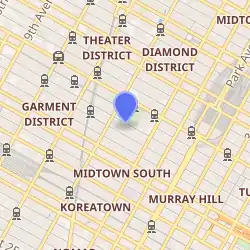American Radiator Building
The American Radiator Building (also known as the American Standard Building) is a 338 ft (103 m), 23-story[1] early skyscraper at 40 West 40th Street in Midtown Manhattan, New York City. It was conceived by the architects John Howells and Raymond Hood,[2] and built in 1924 for the American Radiator Company, five years before it merged with Standard Sanitary Manufacturing Company to form American Radiator and Standard Sanitary Corporation, later known as American Standard. The building is listed on the National Register of Historic Places.
American Radiator Building | |
 The American Radiator Building | |

| |
| Location | 40 West 40th Street Manhattan, New York City |
|---|---|
| Coordinates | 40.752970°N 73.983970°W |
| Built | 1924 |
| Architect | Raymond Hood and André Fouilhoux[1] |
| Architectural style | Gothic Art Deco |
| NRHP reference No. | 80002663 |
| NYCL No. | 0878 |
| Significant dates | |
| Added to NRHP | May 7, 1980 |
| Designated NYCL | November 12, 1974 |
Description

The building's form is based on Eliel Saarinen's unbuilt competition entry for the Tribune Tower, augmented with a strong use of color.[3][4] The architects combined Gothic and modern styles in the design of the building. Black brick on the frontage of the building (symbolizing coal) was selected to give an idea of solidity and to give the building a solid mass. Other parts of the facade were covered in gold bricks (symbolizing fire), and the entry was decorated with marble and black mirrors. Howells and Hood employed the talents of their frequent collaborator Rene Paul Chambellan for the ornamentation and sculptures.
The building was depicted in Georgia O'Keeffe's 1927 painting Radiator Building – Night, New York.
Conversion
In 1988, successor company American Standard sold the building to a Japanese company.[5] In 1998, the building was sold to Philip Pilevsky for $150 million.[6] Three years afterwards, the American Radiator Building was converted into The Bryant Park Hotel with 130 rooms and a theater in the basement. The landmark status of the exterior required that the conversion pay special attention to the renovation of the facade decor, and prohibited proposed changes such as bigger guestroom windows.
References
- Designation as New York City Landmark, 1974
- White, Norval & Willensky, Elliot (2000). AIA Guide to New York City (4th ed.). New York: Three Rivers Press. p. 229. ISBN 978-0-8129-3107-5.
- Henry, Jay C. (1993). Architecture in Texas, 1895–1945. University of Texas Press. pp. 217–218. ISBN 0-292-73072-1.
- Solomonson, Katharine (2003). The Chicago Tribune Tower Competition: Skyscraper Design and Cultural Change in the 1920s (2 ed.). University of Chicago Press. p. 247. ISBN 0-226-76800-7.
- Gray, Christopher (February 20, 1994). "Streetscapes/The American Radiator Building; A 1924 Precursor of Art Deco". The New York Times. ISSN 0362-4331. Retrieved June 24, 2018.
- Dunlap, David W. (August 11, 1999). "Commercial Real Estate; Turning Radiator Building Into a Boutique Hotel". The New York Times. ISSN 0362-4331. Retrieved June 24, 2018.
External links
| Wikimedia Commons has media related to American Radiator Building. |

